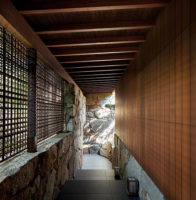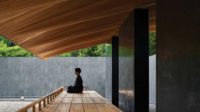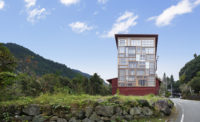Some buildings merely coexist with the landscape, but others enhance it. Erretegia, a restaurant specializing in Basque cuisine and designed by the Tokyo architect Hiroshi Nakamura, does both. Overlooking Japan’s Inland Sea near Hiroshima, some 450 miles southwest of Tokyo, the bar-shaped building hugs the ground, while a transparent wrapping barely separates inside from out. The linear structure, topped with an oversize pitched roof, deftly underscores the beauty of its surroundings, enhanced by Landscape Niwatan Design + Artisan Office.
Additional Content:
Jump to credits & specifications
Erretegia (Basque for “grill house”) belongs to the Bellavista Spa & Marina Onomichi, a resort hotel that opened in the 1970s in this scenic coastal area. In addition to designing the 40-seat glassed-in dining room, Nakamura renovated the hotel’s original restaurant as the Chef’s Table, a 24-seat eat-in kitchen that also serves Erretegia. The hotel, which belongs to the nearby Tsuneishi Shipbuilding Company, started as a place to put up company visitors and local tourists. When the facility began showing its age, the owner decided to convert the property into a destination wedding venue and hired Nakamura to design the white, spiraling Ribbon Chapel in 2013, followed by the remodeling of the hotel lobby and terrace, the reconfiguring of a luxury guest suite, and the design of Erretegia, whose cuisine takes advantage of the local fish and produce.
The dining room abuts the resort’s swimming pool, making the most of the coastline view and minimizing the encroachment on the lawn in back where the hotel may expand. Potential growth also influenced Erretegia’s massing and transparency, since the see-through structure would not block the view for new construction behind it. The hotel also wanted to preserve as many of the existing trees as possible, although inevitably some had to be removed. (Most of those could be relocated near the Ribbon Chapel.) In addition, the design team salvaged lemon trees from a nearby farm and planted them along Erretegia’s east side, buffering the glass walls from the walkway, while providing fruit to the kitchen. Covered paths and terraces connect the dining room to the Chef’s Table just a stone’s throw away.
Envisioned as a garden gazebo, the 62-by-12- foot dining room is just wide enough for a single row of tables with chairs on either side. Overhead, a deep, large—188 feet by 22 feet— red cedar–shingled roof hovers protectively. “The glass is very modern, but the gabled roof is very traditional,” comments Nakamura. The roof’s angled ends recall the area’s historic irimoya farmhouses, and cover outdoor seating. Triangular glass inserts in the gable ends help brighten the interior, while more daylight enters clerestory windows running the length of the building. Four-foot-deep eaves of cedar prevent the sun from hitting the glass walls directly; a signature of Nakamura’s architecture, these overhangs passively control internal heat gain without compromising the sunset views.
Contrasting with the glass, the roof is supported by 72 exposed trusses. Each one consists of three layers made of tiny wood bars—1,600 components in total. Measuring from less than an inch to just over 2 inches, these delicate elements visually offset the roof’s immensity. They were fashioned at a local furniture factory with a numerical cutting machine normally used to craft tables and chairs, a method that provided the precision needed for the trusses’ intricate joinery, characteristic of traditional Japanese carpentry. In lieu of nails, friction and tiny screws alone hold the trusses together.
Assembled on-site, the trusses attach to Vierendeel girders and columns made of galvanized steel. Beyond the steel elements stand the glass walls. These ¾-inch-thick tempered panels are secured by metal sash embedded in the wood deck floor and concealed by the finished wood ceiling. Invisibly joined with sealant, the panes read as a single surface, except where sliding or swing doors take their place. After installation, holes had to be cut in the glass for the eaves’ rafters, which are anchored to the steel girders inside. With a tolerance for error of only about 5⁄64 of an inch, this maneuver was one of the job’s greatest construction challenges.
By comparison, the remodeling of the Chef’s Kitchen was a cakewalk. Entered through a pair of conventional kitchen kick doors, the room is spare and utilitarian. To accommodate both kitchen staff and restaurant patrons, Nakamura enlarged the existing building on two sides and opened both to views of the water with broad windows. Its newly added canopies cut the sun’s rays but allow them to be reflected on the white ceiling. The other interior walls are filled with industrial- grade cooking equipment, including a large built-in roasting spit. Stainless-steel dining tables that are extensions of the kitchen counters enable patrons to chat with the chef while watching their meals take shape.
Like the Bellavista, many vintage Japanese hotels are in need of a reboot. With hospitality commissions in the works in Kyoto as well as Taiwan, Nakamura is becoming the go-to guy for these renovations. “Houses may be appreciated by a few people,” he reasons, “but hotels can be enjoyed by many.” With the influx of tourists increasing and the 2020 Olympics in Tokyo fast approaching, Nakamura seems to be in the right place at the right time.
CreditsArchitect: Hiroshi Nakamura & NAP— Hiroshi Nakamura, principal; Yasuhiro
Landscape: Landscape Niwatan Design + Artisan Office
Consultants: Yamada Noriaki Structural Design Office (structural); ZO Consulting Engineers (facilities); Toshiko Ferrier (coordinator); Setouchi Holdings (construction manager)
Contractor: Daiwa Construction
|
SpecificationsWood roof frame Japan Kenzai Steel columns Fukuei Tekko Glass ADF Ayabe Floor Kousei |











Post a comment to this article
Report Abusive Comment